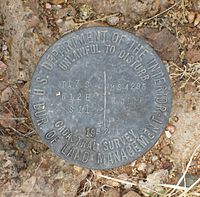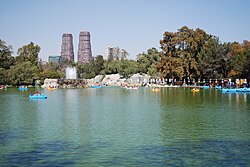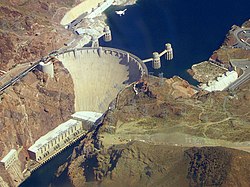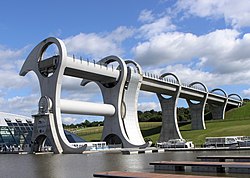Niskogradnja
Један корисник управо ради на овом чланку. Молимо остале кориснике да му допусте да заврши са радом. Ако имате коментаре и питања у вези са чланком, користите страницу за разговор.
Хвала на стрпљењу. Када радови буду завршени, овај шаблон ће бити уклоњен. Напомене
|


Niskogradnja je profesionalna inženjerska disciplina koja se bavi projektovanjem, izgradnjom i održavanjem fizičkog i prirodno izgrađenog okruženja, uključujući javne radove kao što su putevi, mostovi, kanali, brane, aerodromi, kanalizacioni sistemi, cevovodi, i železnice.[1][2]
Niskogradnja je tradicionalno podeljena na nekoliko poddisciplina. Smatra se jednom od najstarijih inženjerskih disciplina[3][4] Niskogradnja se može odvijati u javnom sektoru od opštinskih odeljenja za javne radove do saveznih vladinih agencija, kao i u privatnom sektoru od lokalnih firmi do kompanija Forčun Global 500.[5]
Istorija[уреди | уреди извор]
Niskogradnja kao disciplina[уреди | уреди извор]
Niskogradnja kao deo građevinarstva je vid primene fizičkih i naučnih principa za rešavanje društvenih problema, a njena istorija je zamršeno povezana sa napretkom u razumevanju fizike i matematike kroz istoriju. Pošto je niskogradnja široka profesija, uključujući nekoliko specijalizovanih poddisciplina, njena istorija je povezana sa poznavanjem struktura, nauke o materijalima, geografije, geologije, tla, hidrologije, nauke o životnoj sredini, mehanike, upravljanja projektima i drugim oblastima.[6]
Kroz antičku i srednjovekovnu istoriju većinu arhitektonskog projektovanja i izgradnje izvodile su zanatlije, kao što su klesari i stolari, uzdižući se do uloge majstora graditelja. Znanje se zadržavalo u cehovima i retko je poboljšavano napredcima. Strukture, putevi i infrastruktura koji su postojali su se ponavljali, pri čemu je povećanje obima bilo postepeno.[7]
Jedan od najranijih primera naučnog pristupa fizičkim i matematičkim problemima primenljivim na građevinarstvo je Arhimedov rad u 3. veku pre nove ere, uključujući Arhimedov princip, koji je u osnovi našeg razumevanja uzgona, i praktična rešenja kao što je Arhimedov vijak. Bramagupta, indijski matematičar, koristio je aritmetiku u 7. veku nove ere, zasnovanu na hindu-arapskim brojevima, za proračune iskopavanja (zapremina).[8]
Niskogradnja kao profesija[уреди | уреди извор]
Inženjerstvo je bio aspekt života od početaka ljudskog postojanja. Najranija praksa građevinarstva je verovatno počela između 4000. i 2000. pre nove ere u starom Egiptu, civilizaciji doline Inda i Mesopotamiji (drevni Irak) kada su ljudi počeli da napuštaju nomadsko postojanje, stvarajući potrebu za izgradnjom skloništa. Tokom ovog vremena, transport je postao sve važniji što je dovelo do razvoja točka i jedrenja.

Sve do modernog vremena nije postojala jasna razlika između građevinarstva i arhitekture, a termin inženjer i arhitekta su uglavnom bile geografske varijacije koje se odnose na isto zanimanje i često se koriste naizmenično.[9] Konstrukcije piramida u Egiptu (oko 2700–2500 pne) predstavljaju neke od prvih primera velikih konstrukcija u istoriji. Drevne istorijske tekovine niskogradnje obuhvataju sistem upravljanja vodama Kanat u današnjem Iranu (najstariji među njima je stariji od 3000 godina i duži od 71 km (44 mi)[10]), Apijski put rimskih inženjera (oko 312 pne), i stupe izgrađene u drevnoj Šri Lanki kao Jetavanaramaja[11][12][13][14] i opsežne radove na navodnjavanju u Anuradapuri. Rimljani su razvili civilne strukture širom svog carstva, uključujući posebno akvadukte,[15][16][17] insule,[18][19][20][21] luke, mostove, brane i puteve.

U 18. veku, termin građevinsko inženjerstvo je skovan da inkorporira sve što je civilno za razliku od vojnog inženjeringa.[4] Godine 1747, u Francuskoj je osnovana prva ustanova za nastavu građevinarstva, Nacionalna škola za mostove i puteve; i više primera usledilo je u drugim evropskim zemljama, poput Španije.[26] Prvi samoproglašeni građevinski inženjer bio je Džon Smiton, koji je konstruisao svetionik Ediston.[3][27] Godine 1771, Smiton i neke njegove kolege osnovali su Smitonsko društvo građevinskih inženjera, grupu lidera struke koji su se neformalno sastajali. Iako je bilo dokaza o nekim tehničkim sastancima, delovanje grupe je u maloj meri prevazilazilo uobičajene aktivnosti društvenog života.

Godine 1818, u Londonu je osnovana Institucija građevinskih inženjera,[28] a 1820. ugledni inženjer Tomas Telford postao je njen prvi predsednik. Institucija je dobila Kraljevsku povelju 1828. godine, kojom je građevinarstvo formalno priznato kao profesija. Ova povelja definiše građevinarstvo kao:
umetnost usmeravanja velikih izvora moći u prirodi za upotrebu i pogodnost čoveka, kao sredstva za proizvodnju i saobraćaj u državama, kako za spoljnu tako i unutrašnju trgovinu, koja se primenjuje u izgradnji puteva, mostova, akvadukta, kanala, rečnu plovidbu i pristaništa za unutrašnju trgovinu i razmenu, i u izgradnji luka, dokova, gatova, lukobrana i svetionika, i u veštini navigacije veštačkom snagom za potrebe trgovine, kao i u izgradnji i primeni mašina, i u drenaži gradova i naselja.[29]
Građevinsko obrazovanje[уреди | уреди извор]
Prvi privatni koledž koji je predavao građevinsko inženjerstvo u Sjedinjenim Državama bio je Univerzitet Norvič, koji je 1819. osnovao kapetan Alden Partridž.[30] Prve diplome građevinarstva u Sjedinjenim Državama dodelio je Politehnički institut Rensilier 1835. godine.[31][32] Prvu takvu diploma koja je dodeljena ženi dao je Univerzitet Kornel Nori Stenton Bleč 1905. godine.[33]
U Velikoj Britaniji tokom ranog 19. veka, podela između građevinskog i vojnog inženjerstva (koje je predavala Kraljevska vojna akademija u Vulviču), zajedno sa zahtevima industrijske revolucije, pokrenula je nove inicijative za inženjersko obrazovanje: Klasa građevinarstva i rudarstva osnovana je na Kraljevskom koledžu u Londonu 1838. godine, uglavnom kao odgovor na rast železničkog sistema i potreba za kvalifikovanijim inženjerima, privatni Koledž za građevinske inženjere u Patniju je osnovan 1839. godine, a osnovana je prva katedra za inženjering u Velikoj Britaniji na Univerzitetu u Glazgovu 1840. godine.
Bit građevinske tehnike[уреди | уреди извор]
Građevinska tehnika je veština kojom ljudi od izvornih ili prerađenih darova prirode osmišljeno (planirano) sastavljaju nove tvorevine povezane s tlom, odnosno fiksirane na zemlju, pa se njima koriste.
Prirodni materijali kao što su: kamen, drvo, zemlja (glina), ali i veštački: opeka, kreč, beton i čelik, omogućavanju osmišljeno povezivanje sa tlom u jednu celinu koja se naziva građevinskim objektom ili građevinom.[34][35]

Važnost tehničkog crtanja u suvremenom komuniciranju[уреди | уреди извор]
Kod osmišljavanja neke građevine, objekta ili konstrukcije stručnjak-projektant rešava zadatak na papiru prostoručnim skiciranjem olovkom. Prema usvojenoj prostoručnoj skici elementa ili objekta projektant izrađuje konačan crtež ili nacrt po pravilima tehničkog crtanja. Nacrti moraju biti grafički prikazani tako da ih drugi izvođači, obrtnici, poduzetnici i sl. mogu tačno razumeti i na osnovu crteža izraditi objekt kako ga je projektant zamislio.
Može se reći da su tehnički crteži neka vrsta međunarodnog pisma koje stručnjaci mogu napisati, čitati i razumeti. Prema tome, tehnički crtež mora biti jasan, uredan, precizan i nadasve tačan.
Poddiscipline[уреди | уреди извор]

There are a number of sub-disciplines within the broad field of civil engineering. General civil engineers work closely with surveyors and specialized civil engineers to design grading, drainage, pavement, water supply, sewer service, dams, electric and communications supply. General civil engineering is also referred to as site engineering, a branch of civil engineering that primarily focuses on converting a tract of land from one usage to another. Site engineers spend time visiting project sites, meeting with stakeholders, and preparing construction plans. Civil engineers apply the principles of geotechnical engineering, structural engineering, environmental engineering, transportation engineering and construction engineering to residential, commercial, industrial and public works projects of all sizes and levels of construction.
Coastal engineering[уреди | уреди извор]

Coastal engineering is concerned with managing coastal areas. In some jurisdictions, the terms sea defense and coastal protection mean defense against flooding and erosion, respectively. Coastal defense is the more traditional term, but coastal management has become popular as well.
Construction engineering[уреди | уреди извор]
Construction engineering involves planning and execution, transportation of materials, site development based on hydraulic, environmental, structural and geotechnical engineering. As construction firms tend to have higher business risk than other types of civil engineering firms do, construction engineers often engage in more business-like transactions, for example, drafting and reviewing contracts, evaluating logistical operations, and monitoring prices of supplies.
Earthquake engineering[уреди | уреди извор]
Earthquake engineering involves designing structures to withstand hazardous earthquake exposures. Earthquake engineering is a sub-discipline of structural engineering. The main objectives of earthquake engineering are[36] to understand interaction of structures on the shaky ground; foresee the consequences of possible earthquakes; and design, construct and maintain structures to perform at earthquake in compliance with building codes.
Geotechnical engineering[уреди | уреди извор]

Geotechnical engineering studies rock and soil supporting civil engineering systems. Knowledge from the field of soil science, materials science, mechanics, and hydraulics is applied to safely and economically design foundations, retaining walls, and other structures. Environmental efforts to protect groundwater and safely maintain landfills have spawned a new area of research called geo-environmental engineering.[37][38]
Identification of soil properties presents challenges to geotechnical engineers. Boundary conditions are often well defined in other branches of civil engineering, but unlike steel or concrete, the material properties and behavior of soil are difficult to predict due to its variability and limitation on investigation. Furthermore, soil exhibits nonlinear (stress-dependent) strength, stiffness, and dilatancy (volume change associated with application of shear stress), making studying soil mechanics all the more difficult.[37] Geotechnical engineers frequently work with professional geologists, Geological Engineering professionals and soil scientists.[39]
Materials science and engineering[уреди | уреди извор]
Materials science is closely related to civil engineering. It studies fundamental characteristics of materials, and deals with ceramics such as concrete and mix asphalt concrete, strong metals such as aluminum and steel, and thermosetting polymers including polymethylmethacrylate (PMMA) and carbon fibers.
Materials engineering involves protection and prevention (paints and finishes). Alloying combines two types of metals to produce another metal with desired properties. It incorporates elements of applied physics and chemistry. With recent media attention on nanoscience and nanotechnology, materials engineering has been at the forefront of academic research. It is also an important part of forensic engineering and failure analysis.
Site development and planning[уреди | уреди извор]

Site development, also known as site planning, is focused on the planning and development potential of a site as well as addressing possible impacts from permitting issues and environmental challenges.[40]
Structural engineering[уреди | уреди извор]
Structural engineering is concerned with the structural design and structural analysis of buildings, bridges, towers, flyovers (overpasses), tunnels, off shore structures like oil and gas fields in the sea, aerostructure and other structures. This involves identifying the loads which act upon a structure and the forces and stresses which arise within that structure due to those loads, and then designing the structure to successfully support and resist those loads. The loads can be self weight of the structures, other dead load, live loads, moving (wheel) load, wind load, earthquake load, load from temperature change etc. The structural engineer must design structures to be safe for their users and to successfully fulfill the function they are designed for (to be serviceable). Due to the nature of some loading conditions, sub-disciplines within structural engineering have emerged, including wind engineering and earthquake engineering.[41]
Design considerations will include strength, stiffness, and stability of the structure when subjected to loads which may be static, such as furniture or self-weight, or dynamic, such as wind, seismic, crowd or vehicle loads, or transitory, such as temporary construction loads or impact. Other considerations include cost, constructibility, safety, aesthetics and sustainability.
Surveying[уреди | уреди извор]
Surveying is the process by which a surveyor measures certain dimensions that occur on or near the surface of the Earth. Surveying equipment such as levels and theodolites are used for accurate measurement of angular deviation, horizontal, vertical and slope distances. With computerisation, electronic distance measurement (EDM), total stations, GPS surveying and laser scanning have to a large extent supplanted traditional instruments. Data collected by survey measurement is converted into a graphical representation of the Earth's surface in the form of a map. This information is then used by civil engineers, contractors and realtors to design from, build on, and trade, respectively. Elements of a structure must be sized and positioned in relation to each other and to site boundaries and adjacent structures.
Although surveying is a distinct profession with separate qualifications and licensing arrangements, civil engineers are trained in the basics of surveying and mapping, as well as geographic information systems. Surveyors also lay out the routes of railways, tramway tracks, highways, roads, pipelines and streets as well as position other infrastructure, such as harbors, before construction.
- Land surveying
In the United States, Canada, the United Kingdom and most Commonwealth countries land surveying is considered to be a separate and distinct profession. Land surveyors are not considered to be engineers, and have their own professional associations and licensing requirements. The services of a licensed land surveyor are generally required for boundary surveys (to establish the boundaries of a parcel using its legal description) and subdivision plans (a plot or map based on a survey of a parcel of land, with boundary lines drawn inside the larger parcel to indicate the creation of new boundary lines and roads), both of which are generally referred to as Cadastral surveying.

- Construction surveying
Construction surveying is generally performed by specialized technicians. Unlike land surveyors, the resulting plan does not have legal status. Construction surveyors perform the following tasks:
- Surveying existing conditions of the future work site, including topography, existing buildings and infrastructure, and underground infrastructure when possible;
- "lay-out" or "setting-out": placing reference points and markers that will guide the construction of new structures such as roads or buildings;
- Verifying the location of structures during construction;
- As-Built surveying: a survey conducted at the end of the construction project to verify that the work authorized was completed to the specifications set on plans.
Transportation engineering[уреди | уреди извор]
Transportation engineering is concerned with moving people and goods efficiently, safely, and in a manner conducive to a vibrant community. This involves specifying, designing, constructing, and maintaining transportation infrastructure which includes streets, canals, highways, rail systems, airports, ports, and mass transit. It includes areas such as transportation design, transportation planning, traffic engineering, some aspects of urban engineering, queueing theory, pavement engineering, Intelligent Transportation System (ITS), and infrastructure management.
Municipal or urban engineering[уреди | уреди извор]


Municipal engineering is concerned with municipal infrastructure. This involves specifying, designing, constructing, and maintaining streets, sidewalks, water supply networks, sewers, street lighting, municipal solid waste management and disposal, storage depots for various bulk materials used for maintenance and public works (salt, sand, etc.), public parks and cycling infrastructure. In the case of underground utility networks, it may also include the civil portion (conduits and access chambers) of the local distribution networks of electrical and telecommunications services. It can also include the optimization of waste collection and bus service networks. Some of these disciplines overlap with other civil engineering specialties, however municipal engineering focuses on the coordination of these infrastructure networks and services, as they are often built simultaneously, and managed by the same municipal authority. Municipal engineers may also design the site civil works for large buildings, industrial plants or campuses (i.e. access roads, parking lots, potable water supply, treatment or pretreatment of waste water, site drainage, etc.)
Water resources engineering[уреди | уреди извор]

Water resources engineering is concerned with the collection and management of water (as a natural resource). As a discipline it therefore combines elements of hydrology, environmental science, meteorology, conservation, and resource management. This area of civil engineering relates to the prediction and management of both the quality and the quantity of water in both underground (aquifers) and above ground (lakes, rivers, and streams) resources. Water resource engineers analyze and model very small to very large areas of the earth to predict the amount and content of water as it flows into, through, or out of a facility. Although the actual design of the facility may be left to other engineers.
Hydraulic engineering is concerned with the flow and conveyance of fluids, principally water. This area of civil engineering is intimately related to the design of pipelines, water supply network, drainage facilities (including bridges, dams, channels, culverts, levees, storm sewers), and canals. Hydraulic engineers design these facilities using the concepts of fluid pressure, fluid statics, fluid dynamics, and hydraulics, among others.

Civil engineering systems[уреди | уреди извор]
Civil engineering systems is a discipline that promotes the use of systems thinking to manage complexity and change in civil engineering within its wider public context. It posits that the proper development of civil engineering infrastructure requires a holistic, coherent understanding of the relationships between all of the important factors that contribute to successful projects while at the same time emphasizing the importance of attention to technical detail. Its purpose is to help integrate the entire civil engineering project life cycle from conception, through planning, designing, making, operating to decommissioning.[42][43]
Vidi još[уреди | уреди извор]
- Građevine (građevinski objekti)
Reference[уреди | уреди извор]
- ^ „History and Heritage of Civil Engineering”. American Society of Civil Engineers. Архивирано из оригинала 16. 2. 2007. г. Приступљено 2007-08-08.
- ^ „What is Civil Engineering”. Institution of Civil Engineers. 2022-01-14. Приступљено 2017-05-15.
- ^ а б „What is Civil Engineering?”. Canadian Society for Civil Engineering. Архивирано из оригинала 12. 8. 2007. г. Приступљено 2007-08-08.
- ^ а б „Civil engineering”. Encyclopædia Britannica. Приступљено 2007-08-09.
- ^ „Working in the Public Sector Versus Private Sector for Civil Engineering Professionals”. The Civil Engineering Podcast. Engineering Management Institute. 5. 6. 2019.
- ^ Baveystock, Nick (8. 8. 2013). „So what does a civil engineer do, exactly?”. The Guardian. Приступљено 11. 9. 2020.
- ^ Saouma, Victor E. „Lecture Notes in Structural Engineering” (PDF). University of Colorado. Архивирано из оригинала (PDF) 19. 4. 2011. г. Приступљено 2. 11. 2007.
- ^ Colebrook, Henry Thomas (1817). Algebra: with Arithmetic and mensuration. London.
- ^ Murray, Peter (1986). The Architecture of the Italian Renaissance. Knopf Doubleday. ISBN 0-8052-1082-2.
- ^ Mays, L. (2010). Ancient Water Technologies. Springer. стр. 4. ISBN 978-90-481-8631-0.
- ^ Ancient Buddhist Mural Painting of India and Sri Lanka. 2002. стр. 204.
- ^ „Tallest stupa”. Guinness World Records (на језику: енглески). Приступљено 2018-01-08.
- ^ Mandawala, P.B. (2002). „The Jetavana Stupa Rediscovered.”. Silhouette-(2002-2003). General Sir John Kotelawala Defence University: 125—133.
- ^ „Jetavanaramaya”. Архивирано из оригинала 2008-01-26. г.
- ^ Gargarin, M. and Fantham, E. (editors). The Oxford Encyclopedia of Ancient Greece and Rome, Volume 1. p. 145.
- ^ Caron, André. „The Aqueducts”. www.maquettes-historiques.net. Приступљено 17. 9. 2017.
- ^ Taylor, Rabun, M., (2002), Tiber River bridges and the development of the ancient city of Rome, pp. 16–17, accessed 22 June 2013
- ^ Chaitanya Iyyer (1. 12. 2009). Land Management. Global India Publications. стр. 147. ISBN 978-93-80228-48-8.
- ^ Gregory S. Aldrete (2004). Daily Life in the Roman City: Rome, Pompeii and Ostia. Greenwood Publishing Group. стр. 78—80. ISBN 978-0-313-33174-9.
- ^ Stephen L. Dyson (1. 8. 2010). Rome: A Living Portrait of an Ancient City. JHU Press. стр. 217—9. ISBN 978-1-4214-0101-0.
- ^ Goldsworthy, Adrian (28. 8. 2014). Augustus: First Emperor of Rome (на језику: енглески). Yale University Press. стр. 19. ISBN 978-0-300-21666-0.
- ^ „EPCC du Pont du Gard”. Culture-epcc.fr. 2008. Приступљено 28. 7. 2012.
- ^ Base Mérimée: PA00103291, Ministère français de la Culture.
- ^ „Map of the Roman Aqueduct to Nîmes”. Athena Review Image Archive. Athena Review. Архивирано из оригинала 2017-11-15. г. Приступљено 2015-09-02.
- ^ „Pont du Gard (Roman Aqueduct)”. UNESCO World Heritage Centre. United Nations Educational, Scientific, and Cultural Organization. Приступљено 17. 10. 2021.
- ^ Dirección General de Obras Públicas Spain (1856). Memoria sobre el estado de las obras públicas en España en 1856 presentada al excmo. sr. Ministro de Fomento por la Dirección General de Obras Públicas. Madrid: National Press.
- ^ Грешка код цитирања: Неважећа ознака
<ref>; нема текста за референце под именомOakes. - ^ „Our history”. Institution of Civil Engineers. 2015-12-02. Приступљено 12. 4. 2018.
- ^ „Institution of Civil Engineers' website”. Приступљено 26. 12. 2007.
- ^ „Norwich University Legacy Website”. Архивирано из оригинала 6. 7. 2014. г. Приступљено 15. 12. 2008.
- ^ Griggs, Francis E Jr. "Amos Eaton was Right!". Journal of Professional Issues in Engineering Education and Practice, Vol. 123, No. 1, January 1997, pp. 30–34.
- ^ „RPI Timeline”. Архивирано из оригинала 2. 7. 2014. г. Приступљено 14. 9. 2007.
- ^ „Nora Stanton Blatch Barney”. Encyclopædia Britannica Online. Приступљено 8. 10. 2010.
- ^ „Penn State Engineering: Architectural Engineering | What is architectural engineering?”. www.ae.psu.edu. Приступљено 2020-11-24.
- ^ „What is Architectural Engineering?”. Civil, Architectural and Environmental Engineering. The University of Texas at Austin.
- ^ Chen, W-F; Scawthorn, C. (2003), „Chapter 2”, Earthquake Engineering Handbook, CRC Press, ISBN 0-8493-0068-1
- ^ а б Mitchell, James Kenneth (1993). Fundamentals of Soil Behavior (2nd изд.). John Wiley and Sons. стр. 1—2.
- ^ Shroff, Arvind V.; Shah, Dhananjay L. (2003). Soil Mechanics and Geotechnical Engineering. Taylor & Francis. стр. 1—2.
- ^ „Geotechnical/Geological Engineering” (PDF). Professional Careers in the Mineral Industry. The Australasian Institute of Mining and Metallurgy. Архивирано (PDF) из оригинала 2008-07-20. г. Приступљено 30. 5. 2018.
- ^ „Site Development and Planning”. Nobis Group. Приступљено 7. 9. 2020.
- ^ Narayanan, R; Beeby, A (2003). Introduction to Design for Civil Engineers. London: Spon.
- ^ Labi, Samuel (2014). Introduction to Civil Engineering Systems: A Systems Perspective to the Development of Civil Engineering Facilities. John Wiley. ISBN 978-0-470-53063-4.
- ^ Blockley, David; Godfrey, Patrick (2017). Doing it Differently: Systems for Rethinking Infrastructure (2nd изд.). London: ICE Publications. ISBN 978-0-7277-6082-1.
Literatura[уреди | уреди извор]
- W.F. Chen; J.Y. Richard Liew, ур. (2002). The Civil Engineering Handbook. CRC Press. ISBN 978-0-8493-0958-8.
- Jonathan T. Ricketts; M. Kent Loftin; Frederick S. Merritt, ур. (2004). Standard handbook for civil engineers (5 изд.). McGraw Hill. ISBN 978-0-07-136473-7.
- Muir Wood, David (2012). Civil Engineering: a very short introduction. New York: Oxford University Press. ISBN 978-0-19-957863-4.
- Blockley, David (2014). Structural Engineering: a very short introduction. New York: Oxford University Press. ISBN 978-0-19-967193-9.
- Dean, R.G.; Dalrymple, R.A. (2004), Coastal Processes with Engineering Applications, Cambridge University Press, Bibcode:2004cpea.book.....D, ISBN 9780521602754
- Hughes, S.A. (1993), Physical Models and Laboratory Techniques in Coastal Engineering, Advanced series on ocean engineering, World Scientific, ISBN 9789810215415
- Kamphuis, J.W. (2010), Introduction to Coastal Engineering and Management, Advanced series on ocean engineering, World Scientific, ISBN 9789812834843
- Kraus, N.C. (1996), History and Heritage of Coastal Engineering, American Society of Civil Engineers, ISBN 9780784474143
- Sorensen, R. (2013), Basic Coastal Engineering, Springer, ISBN 9781475726657
- International Journal of Emergency Management, ISSN 1741-5071 (electronic) ISSN 1471-4825 (paper), Inderscience Publishers
- Journal of Homeland Security and Emergency Management ISSN 1547-7355, Bepress
- Australian Journal of Emergency Management (electronic) ISSN 1324-1540 (paper), Emergency Management Australia
- Karanasios, S. (2011). In R. Heeks & A. Ospina (Eds.). Manchester: Centre for Development Informatics, University of Manchester
- The ALADDIN Project, a consortium of universities developing automated disaster management tools
- Emergency Management Australia (2003) Community Developments in Recovering from Disaster, Commonwealth of Australia, Canberra
- Plan and Preparation: Surviving the Zombie Apocalypse, (paperback), CreateSpace, Introductory concepts to planning and preparing for emergencies and disasters of any kind.
- Bates and Jackson, 1980, Glossary of Geology: American Geological Institute.
- Krynine and Judd, 1957, Principles of Engineering Geology and Geotechnics: McGraw-Hill, New York.
- Holtz, R. and Kovacs, W. (1981), An Introduction to Geotechnical Engineering, Prentice-Hall, Inc. ISBN 0-13-484394-0
- Bowles, J. (1988), Foundation Analysis and Design, McGraw-Hill Publishing Company. ISBN 0-07-006776-7
- Cedergren, Harry R. (1977), Seepage, Drainage, and Flow Nets, Wiley. ISBN 0-471-14179-8
- Kramer, Steven L. (1996), Geotechnical Earthquake Engineering, Prentice-Hall, Inc. ISBN 0-13-374943-6
- Freeze, R.A. & Cherry, J.A., (1979), Groundwater, Prentice-Hall. ISBN 0-13-365312-9
- Lunne, T. & Long, M.,(2006), Review of long seabed samplers and criteria for new sampler design, Marine Geology, Vol 226, p. 145–165
- Mitchell, James K. & Soga, K. (2005), Fundamentals of Soil Behavior 3rd ed., John Wiley & Sons, Inc. ISBN 978-0-471-46302-3
- Rajapakse, Ruwan., (2005), "Pile Design and Construction", 2005. ISBN 0-9728657-1-3
- Fang, H.-Y. and Daniels, J. (2005) Introductory Geotechnical Engineering : an environmental perspective, Taylor & Francis. ISBN 0-415-30402-4
- NAVFAC (Naval Facilities Engineering Command) (1986) Design Manual 7.01, Soil Mechanics, US Government Printing Office
- NAVFAC (Naval Facilities Engineering Command) (1986) Design Manual 7.02, Foundations and Earth Structures, US Government Printing Office
- NAVFAC (Naval Facilities Engineering Command) (1983) Design Manual 7.03, Soil Dynamics, Deep Stabilization and Special Geotechnical Construction, US Government Printing Office
- Terzaghi, K., Peck, R.B. and Mesri, G. (1996), Soil Mechanics in Engineering Practice 3rd Ed., John Wiley & Sons, Inc. ISBN 0-471-08658-4
- Santamarina, J.C., Klein, K.A., & Fam, M.A. (2001), "Soils and Waves: Particulate Materials Behavior, Characterization and Process Monitoring", Wiley, ISBN 978-0-471-49058-6
- Firuziaan, M. and Estorff, O., (2002), "Simulation of the Dynamic Behavior of Bedding-Foundation-Soil in the Time Domain", Springer Verlag.
- „Gov.ns.ca”. Gov.ns.ca. Архивирано из оригинала 21. 7. 2011. г. Приступљено 2. 7. 2011.
Spoljašnje veze[уреди | уреди извор]
| Библиотечки ресурси о Niskogradnja |
